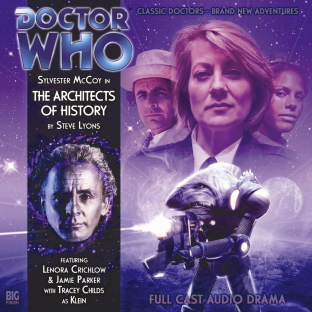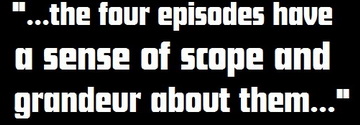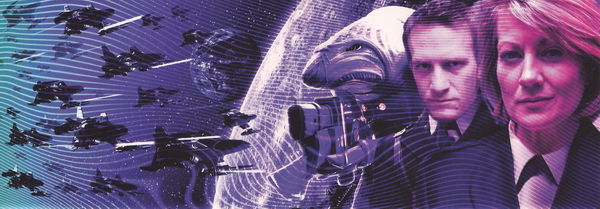|
PREVIOUS
NEXT

The Architects
of History
MARCH 2010
(4 EPISODES)



I should begin by
saying that I have loved Big Finish’s move towards these mini-seasons
within the monthly range. This innovative structure has allowed the
writers to tell broader, more intricate and more progressive stories that
as a listener I’ve found engross me much more than one-off adventures ever
did. In fact, of late I’ve found that my listening habits have changed
considerably as a result – I now ‘save up’ each trilogy so that I can
listen to it as a whole and fully appreciate its subtleties and finesse.
And in the case of this “Klein Trilogy”, I’m particularly glad that I
forced myself to wait until all three releases were
out before listening to them as, following the cliffhanger ending to
Survival of the Fittest,
the wait for The Architects of History would have been all but
unbearable.
The task of penning Klein’s final adventure fell to her creator and
architect of this trilogy of four, Steve Lyons. I understand that he
originally wanted to write what ultimately became A Thousand Tiny Wings,
but I think it’s far more fitting that he is the one to resolve the arc
that he first set in motion almost ten years ago with his script for
Colditz.
 And
Lyons’ script does not disappoint And
Lyons’ script does not disappoint
in the slightest. Though it is set within
the claustrophobic confines of Earth’s
besieged Moonbase in the mid-21st
century, the four episodes have a
sense of scope and grandeur about
them that put me in mind of Nicholas
Briggs’ recent Viyran masterwork, Blue Forgotten Planet. Much of
this is down to the far-reaching effects that the events depicted have;
after all, as we join the adventure in the first episode, Klein has done
what she set out to do. The Nazis won the Second World War. The Galactic
Reich rules the Earth, and is now making its first aggressive inroads into
a much larger world.
The trouble is, Klein isn’t a Time Lord. For all her fire and intellect,
she simply isn’t capable of sculpting the timeline that she wants. Much
like the tormented Annorax in the Star Trek: Voyager story Year
of Hell, Time just won’t let her. Or at least, Time’s Champion won’t.
“And so another strand breaks…”
I must admit, initially I couldn’t quite grasp the complicated mechanics
of this story, and even now that I’ve had time to reflect on them, I’m
still not sure that I’m interpreting them correctly, but here goes anyway:
when Klein absconds in the TARDIS at the end of Survival of the Fittest,
she goes back in time and sets history back on what she perceives to be
its proper course. As a result the Doctor - just like everyone else in
creation - is changed as a result, therefore the Doctor festering in
prison when Klein arrives at the Moonbase in 2044 is not the Doctor
that we know; not the Doctor that met Klein in 1950s Kenya and took
her for a spin in his ship. Now it’s important to note that Lyons isn’t
painting this Doctor as a ‘parallel’ version of the type that some authors
try and use as way round certain continuity headaches – this is the
“prime” Doctor, for want of a better phrase, and he’s been changed. Our
Doctor is gone, having never existed.
But here’s the really clever bit. For reasons that won’t become clear
until the final episode, the consciousness of the Doctor that we know is
able to commandeer his altered self’s body, literally usurping his life.
This allows Lyons to carry forward the particular dynamics
of the Doctor / Klein relationship that we’ve listened to in the preceding
stories, pushing us towards a conclusion that feels as fluent as it does
rewarding, whilst also allowing him to circumvent the inherent problem
with “alternate timeline” stories – the lack of consequence, post-reset
button.
“Not a pleasant thought, is it? That your past might not be your own. That
someone else might have looked at your life and decided that it needed a
few small changes...”
As the “prime” Doctor has appropriated his alternate self’s body slap-bang
in the middle of a trademark master plan, he’s clueless as to what his
alternate self’s been up to. And whilst he can deduce from the Selachians’
incongruous presence that he had manipulated them into attacking the
Moonbase so that they’d destroy Klein’s TARDIS, other details are
completely overlooked. “Details” like his companion, Rachel Cooper, whose
existence he is completely ignorant of.
And this is how Lyons makes us care. As Rachel waits for the timeline to
come crashing down around her, we aren’t moved by her blinking out of
existence but by the thought that
her counterpart in the timeline to-be might never meet the Doctor; might
never live in the figurative sense. Rachel labours for the whole of
this story, and doubtless laboured long before its first episode begins,
to help the Doctor restore a timeline in which her fate is uncertain, and
he isn’t even aware of her efforts. They never even meet.
“Do you want to what I’m
afraid of? I’m
afraid you might not find me, in this new timeline of yours. I’m
afraid that I might live out my small, humdrum life and never know how
much more there was to see. How much more I could have been. Everybody has
to die some time. I accept that. What I can’t
bear is the thought that I might never have lived.”
Lenora Crichlow (Gridlock, Being Human) gives a truly indomitable
performance as the companion who never was, and she’s matched every step
of the way by one of the most impressive casts that Big Finish have ever
assembled. As well as Sylvester McCoy and Tracey Childs, who – needless to
say – are once again absolutely spellbinding here, The Architects of
History is reliant upon some fantastic actors. Most prominently,
History Boy Jamie Parker puts in a memorable turn as the vile Major
Richter, and Ian Hayles does a terrific job of realising nervous Moonbase
cleaner Sam Kirke (despite him looking a bit
like Ross Kemp).
In my view though, the most arresting supporting performance is from
Teachers star Lloyd McGuire, who plays malcontent Moonbase Commandant,
Generalleutnant Tendexter. In the space of two hours, Tendexter goes from
disgruntled bureaucrat to meek victim to defiant leader. It’s a
wonderfully layered performance that really has you rooting for the old
wardog
by
the death.

Above:
Whilst audio drama should work independently, a little
visual stimulation never goes amiss...
Another reason that I was so excited about The Architects of History
is that it would see the Selachians make their debut in the audio medium.
Lyons’ “walking, armoured sharks” were probably my favourite original
monster to be created for the BBC Books series, and though they are
admittedly only included here because a generic alien race was required,
I’m glad that it was them. Sound designer Jamie Robertson and actor Chris
Porter have conspired to produce a great sound that represents the
menacing monsters perfectly - their every word is muffled by the bubbling
of the water in their armoured suits before being relayed through an
external speaker, and the swishing weight that can be heard in their
footfalls is a constant reminder of their aquatic nature. Artist Alex
Mallinson has to be praised for his evocative rendering of them too.
Whilst audio drama should work independently – and here it does –
a little visual stimulation never goes amiss.
Sadly though, with the melting pot of ingredients that he had to include
in his story, there is little time for Lyons to explore some of the
Selachians more interesting aspects. The fact
that they have to amputate some of their appendages to fit inside their
suits doesn’t seem
to be mentioned, and the tragedy of their
Ockoran
past (or is it their future?) isn’t explored
at all either. As such, I’ll have to re-iterate the plug that Lyons gives
to his novel The Final Sanction in the CD Extras – track it down on
eBay. It’s certainly one of the best, if not the best, second
Doctor novel.
“I was happy in my life, Doctor. I was happy with my world until you came
along;
until you tricked me into taking that first step. You started this.”
On a final note, it has to be said just how effective this story’s ending
is. On the one hand, it’s the ultimate dues ex machina; but on the
other, it strips everything else away and gives both our protagonists
nowhere to go. The Doctor’s blunder gave rise to Klein’s existence and,
for all her many manifold flaws, she has good reason to feel injured by
his treatment of her. And Lyons brings it right back down to just the two
of them in a TARDIS console room, putting the Doctor in a position where
he can’t avoid or delegate his responsibility to resolve the conflict once
and for all.
The story’s closing scene is a thing of beauty. After the penultimate
scene I had expected a dark and brooding, introspective monologue;
instead, Lyons gives us potentially the most uplifting and affirming
climax that he could have done as by hook or by temporal crook, the Doctor
did what he set out to do in Kenya. He “cured” a Nazi.
Inescapably then, The Architects of History makes for a stunning
finale to this audacious mini-season, and a thoroughly satisfying pay-off
to Big Finish’s longest-standing story arc. Lyons’ story completes the
examination of the Doctor and Klein’s opposing philosophies
in the most scrupulous and, I dare say, the most even-handed of ways, and
in the end, he leaves the pair of them with nowhere to run, which for
McCoy and Childs is the greatest gift that he could have given them. And
for us too.
|